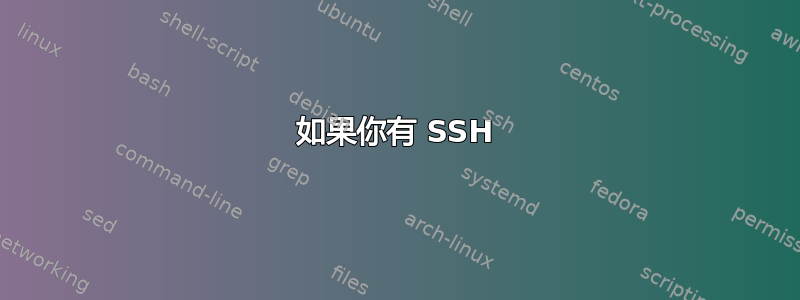
我一直在尝试在 Eclipse 上安装 Android 开发者工具,并按照以下信息操作这个视频。
正如视频所说,我在文件中添加了以下两行代码.bashrc:
export PATH=$(PATH):-/android-sdk/tools/
export PATH=$(PATH):-/android-sdk/platform-tools/
然而,这似乎并没有帮助我在 Eclipse 上安装 Android 文件,因为我仍然遇到问题。更重要的是,似乎我现在无法在终端中执行任何命令,否则会出现重大错误!每次我尝试在终端中执行命令时,我都会收到以下消息:
无法找到该命令,因为 PATH 环境变量中不包含“/usr/bin”。
有什么方法可以恢复.bashrc默认设置吗?
答案1
主意:在 中有 等的备份.bashrc。因此,只需从那里进行复制,即可替换损坏的副本。.profile/etc/skel/.bashrc
警告: 如果你.bashrc用新文件替换该文件,它将删除你对它所做的任何其他修改。例如,可以添加别名, 风俗功能或者小路在 中.bashrc。替换文件时,所有这些修改都将丢失。最好.bashrc在替换之前保留修改的副本。稍后,您可以小心地从中提取所需的部分。要将修改的备份副本保存.bashrc在名为 的主目录中,my_bashrc请在终端中使用以下命令:
/bin/cp ~/.bashrc ~/my_bashrc
为什么/bin/cp:$PATH如果您在更改时弄乱了变量~/.bashrc,则所有可执行文件都将无法从您的终端使用,并且cp将不再起作用。因此,建议您在尝试复制损坏的内容时cp使用其完整路径进行调用。/bin/cp~/.bashrc
最后,在终端中使用以下命令替换~/.bashrc新副本,
/bin/cp /etc/skel/.bashrc ~/
它会~/.bashrc用新的替换损坏的。之后,您需要获取~/.bashrc以便更改立即生效,在终端中写入,
. ~/.bashrc
或者,
source ~/.bashrc
或者,如果这不起作用,您可以关闭终端并再次打开它。
答案2
如果你无法获得可用的 shell
通过文件浏览器
- 打开文件浏览器,转到主目录,按下CtrlH以显示隐藏文件。
.bashrc根据需要进行编辑。 - 打开文件浏览器,进入
/etc/skel,CtrlH按 即可显示隐藏文件。复制.bashrc到主文件夹即可恢复默认设置。
通过运行菜单
- 按AltF2,输入
gedit .bashrc,按Enter。根据需要进行编辑。 - 按,使用AltF2命令
/bin/cp /etc/skel/.bashrc ~/souravc 的回答恢复默认设置。
通过终端
打开终端,忽略你没有 shell。转到编辑→优先→个人资料:
创建新的配置文件,或者编辑当前配置文件,以更改命令:
使用
/bin/bash --norc或/bin/bash --rcfile=/etc/skel/.bashrc。- 启动一个新选项卡(使用自定义配置文件,如果您创建了的话)。根据需要使用工作 shell。
- 完成后,删除自定义配置文件,或者如果编辑了默认配置文件,请取消选中自定义命令选项。
如果你有 SSH
使用自定义命令运行 SSH,这应该可以帮助您绕过.bashrc:
ssh -t <host> dash
该dash外壳(又名/bin/sh)很小,但足以恢复.bashrc。
如果你无法获得 GUI 并且没有 SSH
启动进入恢复模式(如何启动进入恢复模式?),这将为你获取一个 root shell。查找/home你的用户的主目录。
答案3
通过 TTY
ctrl您可以通过按+ alt+进入 TTY,f1然后使用您的用户名和密码登录。ctrl++alt将f7稍后带您返回到您的 GUI。
现在将现有的原始文件复制.bashrc到/etc/skel你的主目录中
cp /etc/skel/.bashrc ~/
如果您不确定自己的是否.profile也发生了变化,甚至可以将其余的都带过来。
cp /etc/skel/.profile ~/
现在,为了.bashrc立即获得效果,您可能需要使用以下方法获取它:
source ~/.bashrc
如果您也确实替换了.profile,则需要重新启动才能使其生效。
答案4
我尝试了上述答案,但由于某种原因,我的/etc/skel/目录中没有正确的文件。
~/.bashrc我在这里找到了默认文件的副本Mario Bonales 的 GitHub Gist。为确保完整性,将完整脚本复制到此处。
# ~/.bashrc: executed by bash(1) for non-login shells.
# see /usr/share/doc/bash/examples/startup-files (in the package bash-doc)
# for examples
# If not running interactively, don't do anything
[ -z "$PS1" ] && return
# don't put duplicate lines in the history. See bash(1) for more options
# ... or force ignoredups and ignorespace
HISTCONTROL=ignoredups:ignorespace
# append to the history file, don't overwrite it
shopt -s histappend
# for setting history length see HISTSIZE and HISTFILESIZE in bash(1)
HISTSIZE=1000
HISTFILESIZE=2000
# check the window size after each command and, if necessary,
# update the values of LINES and COLUMNS.
shopt -s checkwinsize
# make less more friendly for non-text input files, see lesspipe(1)
[ -x /usr/bin/lesspipe ] && eval "$(SHELL=/bin/sh lesspipe)"
# set variable identifying the chroot you work in (used in the prompt below)
if [ -z "$debian_chroot" ] && [ -r /etc/debian_chroot ]; then
debian_chroot=$(cat /etc/debian_chroot)
fi
# set a fancy prompt (non-color, unless we know we "want" color)
case "$TERM" in
xterm-color) color_prompt=yes;;
esac
# uncomment for a colored prompt, if the terminal has the capability; turned
# off by default to not distract the user: the focus in a terminal window
# should be on the output of commands, not on the prompt
#force_color_prompt=yes
if [ -n "$force_color_prompt" ]; then
if [ -x /usr/bin/tput ] && tput setaf 1 >&/dev/null; then
# We have color support; assume it's compliant with Ecma-48
# (ISO/IEC-6429). (Lack of such support is extremely rare, and such
# a case would tend to support setf rather than setaf.)
color_prompt=yes
else
color_prompt=
fi
fi
if [ "$color_prompt" = yes ]; then
PS1='${debian_chroot:+($debian_chroot)}\[\033[01;32m\]\u@\h\[\033[00m\]:\[\033[01;34m\]\w\[\033[00m\]\$ '
else
PS1='${debian_chroot:+($debian_chroot)}\u@\h:\w\$ '
fi
unset color_prompt force_color_prompt
# If this is an xterm set the title to user@host:dir
case "$TERM" in
xterm*|rxvt*)
PS1="\[\e]0;${debian_chroot:+($debian_chroot)}\u@\h: \w\a\]$PS1"
;;
*)
;;
esac
# enable color support of ls and also add handy aliases
if [ -x /usr/bin/dircolors ]; then
test -r ~/.dircolors && eval "$(dircolors -b ~/.dircolors)" || eval "$(dircolors -b)"
alias ls='ls --color=auto'
#alias dir='dir --color=auto'
#alias vdir='vdir --color=auto'
alias grep='grep --color=auto'
alias fgrep='fgrep --color=auto'
alias egrep='egrep --color=auto'
fi
# some more ls aliases
alias ll='ls -alF'
alias la='ls -A'
alias l='ls -CF'
# Add an "alert" alias for long running commands. Use like so:
# sleep 10; alert
alias alert='notify-send --urgency=low -i "$([ $? = 0 ] && echo terminal || echo error)" "$(history|tail -n1|sed -e '\''s/^\s*[0-9]\+\s*//;s/[;&|]\s*alert$//'\'')"'
# Alias definitions.
# You may want to put all your additions into a separate file like
# ~/.bash_aliases, instead of adding them here directly.
# See /usr/share/doc/bash-doc/examples in the bash-doc package.
if [ -f ~/.bash_aliases ]; then
. ~/.bash_aliases
fi
# enable programmable completion features (you don't need to enable
# this, if it's already enabled in /etc/bash.bashrc and /etc/profile
# sources /etc/bash.bashrc).
if [ -f /etc/bash_completion ] && ! shopt -oq posix; then
. /etc/bash_completion
fi




